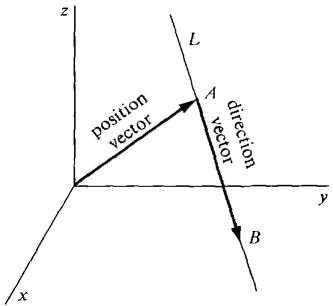| The ebook Elementary Calculus is based on material originally written by H.J. Keisler. For more information please read the copyright pages. |

|

Home  Vectors Vectors  Vectors and Lines in Space Vectors and Lines in Space  Lines in Space Lines in Space |
|||






|
|||
Lines in Space
The position vector of a point P(p1, p2, p3) in space is the vector P = p1i + p2j + p3k. X denotes the variable vector X = xi + yj + zk. We shall now define the notion of a line in space. The simplest way to describe a line in space is by a vector equation. DEFINITION Let P be a vector and D a nonzero vector in space. The line with the vector equation X = P + tD is the set of all points X such that X = P + tD for some scalar t. The vector equation can also be written as a set of parametric equations x = p1 + d1t, y = p2 + d2t, z = p3 + d3t. If t is time, the line is the path of a moving particle in space given by these parametric equations. The three coordinate axes are lines with the following vector equations. x-axis: X = ti, y-axis: X = tj, z-axis: X = tk.
If A is a point on L, let us call A a position vector of L. A vector D is said to be a direction vector of L if D is the vector from one point of L to another point of L. Thus if A and B are distinct position vectors of L, then B - A is a direction vector of L (Figure 10.3.7).
Figure 10.3.7
|
|||
Home  Vectors Vectors  Vectors and Lines in Space Vectors and Lines in Space  Lines in Space Lines in Space |
|||
Last Update: 2006-11-05



